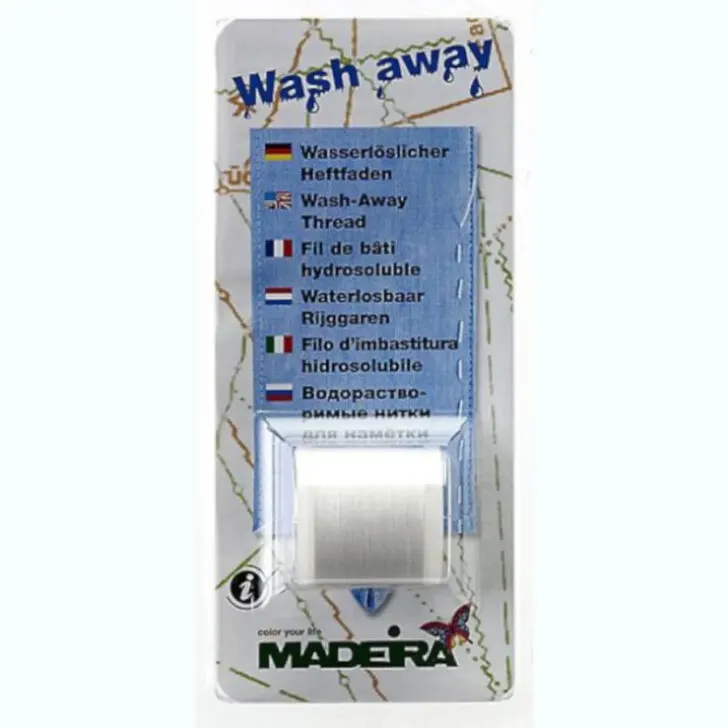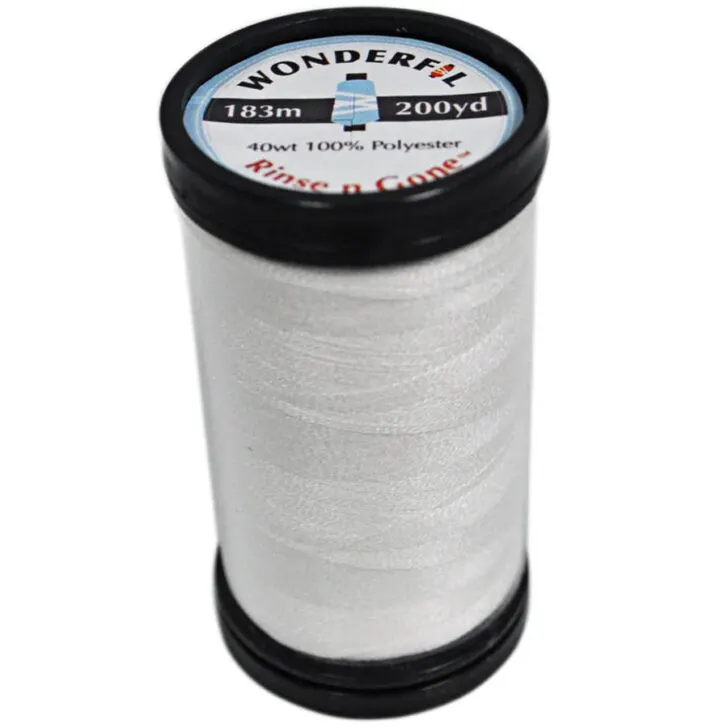Water soluble thread is a unique type of sewing thread that has the ability to dissolve in water. This innovative thread is very useful in some sewing and quilting projects where you need temporary stitching. Let’s explore its composition, how it functions, the benefits it brings to various sewing applications, and its most common uses.

Composition
Water soluble thread is made from a special blend of substances that dissolve in water. The composition generally includes synthetic chemicals, which react with water to disintegrate the thread.
Popular Uses for Water Soluble Thread
Water soluble thread has several applications in sewing. It’s excellent for basting, appliqué, embroidery, and other situations where temporary stitching is necessary.
Basting
Water soluble thread is used for basting when you need to hold fabric layers together temporarily before final stitching. It provides a secure hold without leaving any residue or marks once you dissolve it. It also means there’s no risk of snipping the fabric or the final thread when removing basting stitches.
Applications of Water Soluble Thread in Basting
For quilting, use it to baste the quilt top, batting, and backing together. This method is especially useful for large quilting projects where removing traditional basting stitches can be cumbersome.
In garment making, use water soluble thread for basting together pieces for fitting purposes. Once you adjust the fit and sew the final seams, the basting stitches can be dissolved.
When installing zippers or pockets, water soluble thread can be used to baste them in place before sewing. This ensures that they don’t shift during the final sewing and can be easily removed afterward.
For appliqué work, water soluble thread can temporarily hold appliqué pieces in place on the background fabric. After sewing the appliqué with regular thread, the basting stitches dissolve, leaving a clean finish.
In delicate heirloom sewing projects, where precision is key, water soluble thread can be used to baste lace and other fine details without leaving any trace once the final sewing is complete.
In each of these applications, the use of water soluble thread for basting simplifies the process by providing a temporary hold that is strong enough for handling and manipulation but can be easily removed by dissolving the thread in water.
✅ Related tutorial: Basting Stitch: Why, When And How To Baste In Sewing
Detailed Basting Instructions
Here’s how you can use water soluble thread for basting in detail.
- Choose a water soluble thread from a reputable brand to ensure quality and ease of dissolution.
- Set up your sewing machine with the water soluble thread, or thread a hand-sewing needle if you prefer to baste by hand.
- Lay out the fabric or quilt layers flat and smooth out any wrinkles or puckers.
- Start sewing long, loose stitches along the fabric. These stitches don’t need to be perfect as they are temporary and won’t be seen in the final product.
- Ensure that the stitches cover the necessary areas to keep all layers in place.
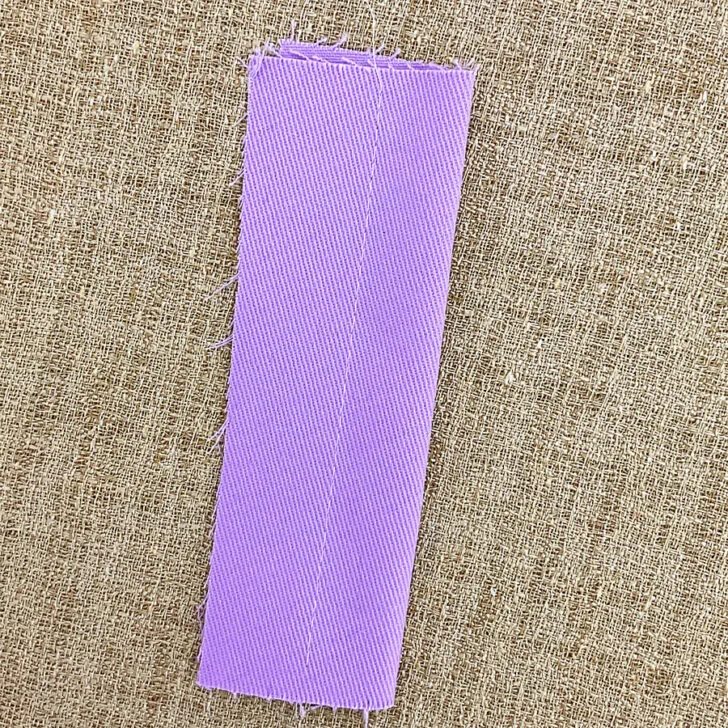
- Once you complete the final sewing or quilting, and you’re ready to remove the basting stitches, dampen the basted seams with a spray bottle, brush, or by submerging the project in water, depending on the fabric and project size.
- Use lukewarm water to ensure the thread dissolves effectively without damaging the fabric.
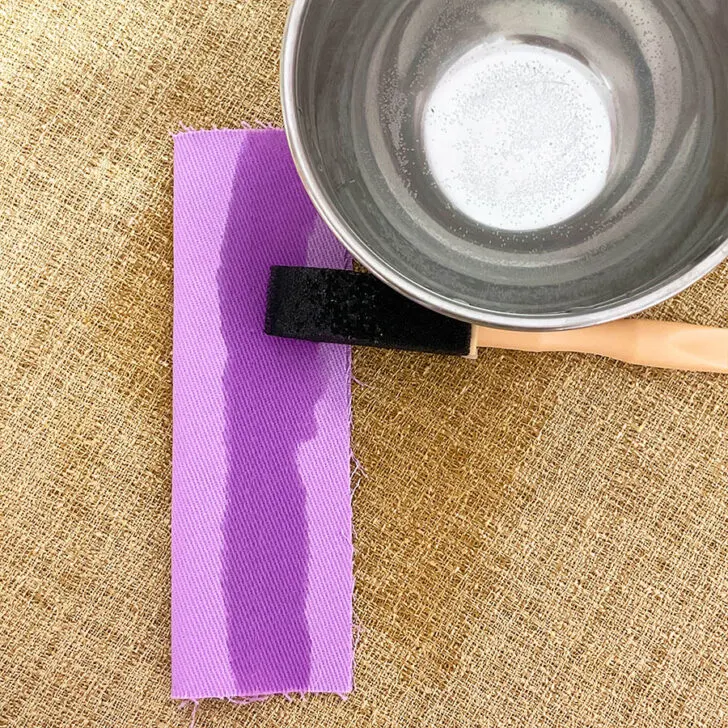
- Wait for a few moments as the thread begins to dissolve. You can gently agitate the fabric in water or lightly rub the basted areas if needed to help the process along.
- After the water soluble thread has dissolved, carefully check if all residue is gone. Dry the fabric or quilt using an iron without steam and following proper care instructions to avoid any water spots or damage.
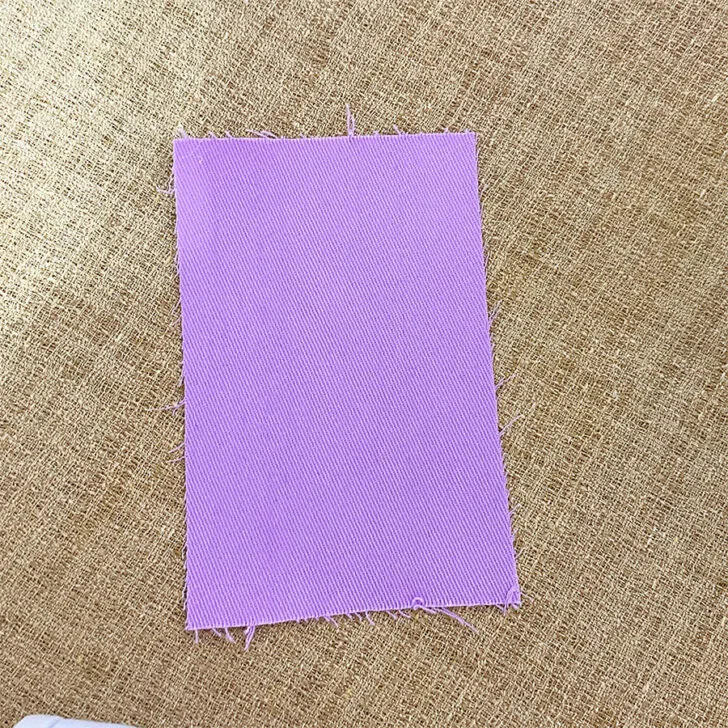
Potential Drawbacks of Water Soluble Thread
While water soluble thread for basting offers many benefits, there are also some drawbacks to consider:
- Water soluble thread can absorb moisture from the air, especially in humid environments, which may cause it to weaken or even break. So proper storage is essential to prevent degradation. It should be kept in a cool, dry place, away from moisture.
- The wash away thread is more expensive than regular thread, which we need to consider.
- You might have problems with your sewing machine’s tension when using water soluble thread, as it tends to be lighter and more delicate than standard threads.
- Due to its delicate nature, water soluble thread may break more easily during the sewing process.
- Not all fabrics react well to water, so using water soluble thread may not be suitable for all materials, particularly those that are water-sensitive or prone to water spots. If I use this thread in my sewing projects, I usually choose it for printed quilting cotton fabric.
Despite these potential downsides, many sewers and quilters find that the advantages of using water soluble thread for basting outweigh the cons, particularly for projects where the temporary stitches need to be removed cleanly and efficiently. It’s always a good practice to weigh these factors and consider the specific needs of your project before deciding to use water soluble thread for basting.
As for me, I have mixed feelings about using water soluble thread for basting. Personally, I don’t like to use water when sewing a dress or a skirt; I prefer to use regular thread for basting. For me, the process of using water to dissolve the thread can be more of a hassle than simply using regular thread for basting.
However, when it comes to knit projects, water soluble thread is definitely very useful. You see, most of the time, I use my serger for making knit garments. Sergers are great because they create these really strong, stretchy seams, but they also leave a lot of threads.
✅ Related tutorial: What Is A Serger & What Can I Do With It?
When I use regular thread for basting and then serge over it, it’s not easy to remove those basting stitches. They are trapped under a web of serger threads.
So I like to use water soluble thread to baste my knit fabrics before taking them to the serger. This way, I don’t have to worry about picking out tiny pieces of thread from those serged seams later on. All I have to do is give the seams a bit of water, and the wash away thread disappears like magic.
✅ Related tutorial: How To Sew Knit Fabric | 23 Expert Tips For Beginners
The same goes for when I’m using a coverstitch on my knits. If I had to remove regular basting stitches from underneath that double row of stitching, it would be so tedious. With water soluble thread, I can avoid that hassle entirely.
✅ Related tutorial: Coverstitch vs. Serger
Water soluble thread is also great for large quilting projects. It saves so much time and effort compared to picking out long lines of basting stitches, and it ensures that quilts come out looking clean and professional without any leftover thread marks.
I absolutely love using water soluble thread for another purpose: sewing together pieces of water soluble stabilizer. Especially for my large hoops, it’s a fantastic way to make use of every bit of stabilizer without any waste.
Embroidery
In my machine embroidery projects, I’ve found a way to utilize water soluble thread that promotes sustainability. I use it to stitch together leftover pieces of water soluble stabilizer from previous projects. By doing this, I avoid wasting stabilizer after each project that requires a water soluble base. It’s an eco-friendly solution that allows me to make the most out of my materials.
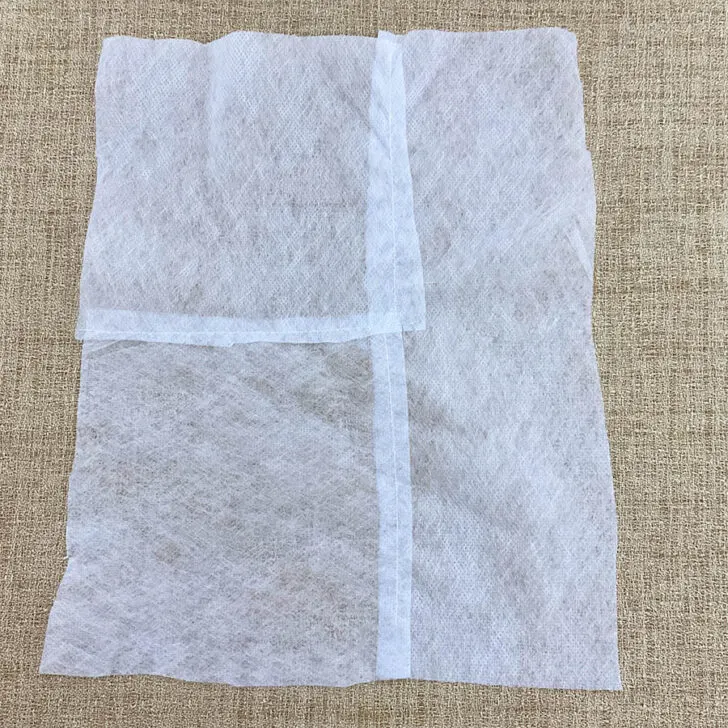
✅ Related tutorial: Sustainable Sewing: Eco-Friendly Techniques For The Modern Sewist
Another interesting use of water soluble thread in my embroidery is in the creation of three-dimensional designs, like flower petals.
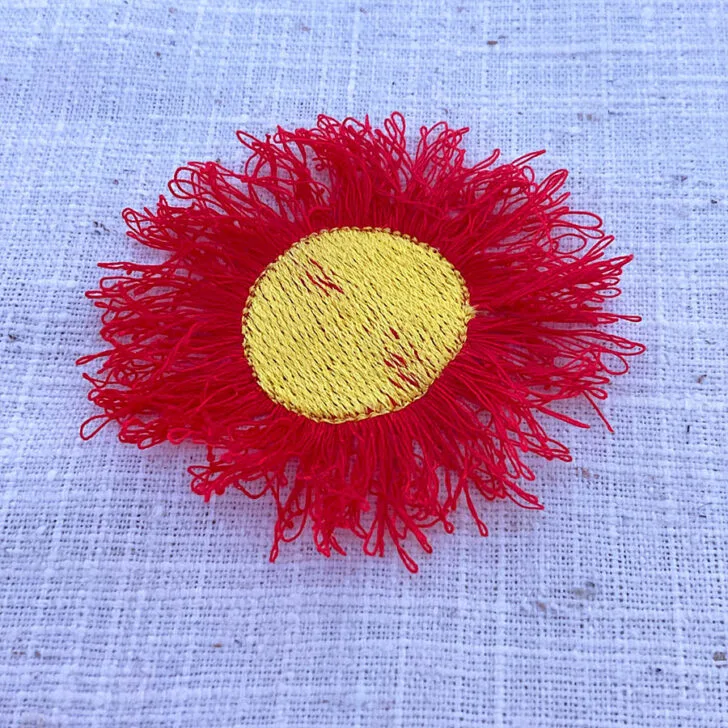
Here’s how I do it: I load my machine with regular embroidery thread in the top needle and water soluble thread in the bobbin. As I embroider the flower, the regular thread forms the visible part of the design, while the water soluble thread in the bobbin holds everything together temporarily.
Then I embroider the center of the flower with regular thread in both the needle and bobbin, which remains intact after the water soluble thread has been dissolved.
Once the embroidery is complete, I expose the piece to water, which dissolves the bobbin thread. This process allows the top thread to puff up slightly, creating a three-dimensional fringe effect. The contrast between the flat center and the raised petals gives the embroidery an unusual appearance.
How Water Soluble Thread Works
The process of using water soluble thread is pretty straightforward: you sew it as usual, and when you expose the thread to water, it dissolves completely.
There are a variety of convenient methods for removal, depending on your specific project needs and the type of fabric involved. Let’s explore the details of how you can effectively dissolve water soluble thread and the best practices to follow.
How To Dissolve Water Soluble Thread?
To dissolve water soluble thread, expose it to water by submerging the fabric in a basin, or running water over it, or spraying it with a water bottle.
Use lukewarm water or the temperature the thread manufacturer recommends for dissolving the thread.
Spray specific areas with a water bottle if you only need to dissolve the thread in certain parts of the project.
Do You Need To Put The Entire Project In Water?
You don’t need to submerge the entire project if only certain areas contain water soluble thread. Instead, apply water locally to those areas with a spray bottle or a damp cloth.
How To Use It With Fabrics Where Water Can Leave Spots?
Test a small, hidden area of the fabric first to check for water spotting.
Use distilled water to minimize the risk of leaving spots, as it lacks the minerals found in tap water.
Wet the fabric evenly to avoid water spots; sometimes submerging the fabric completely can help achieve this.
I prefer to use it for printed fabric. The prints are so forgiving; nobody wouldn’t even know if you had been splashing water around.
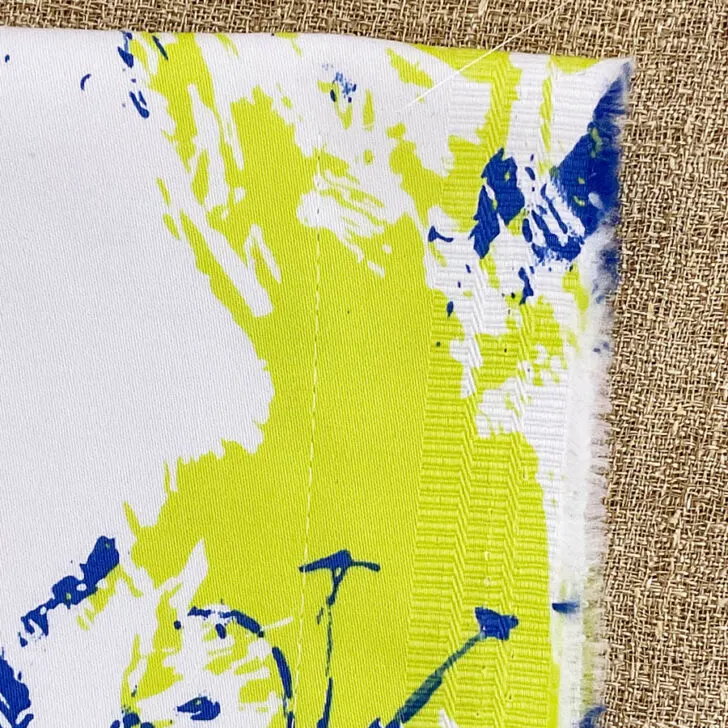
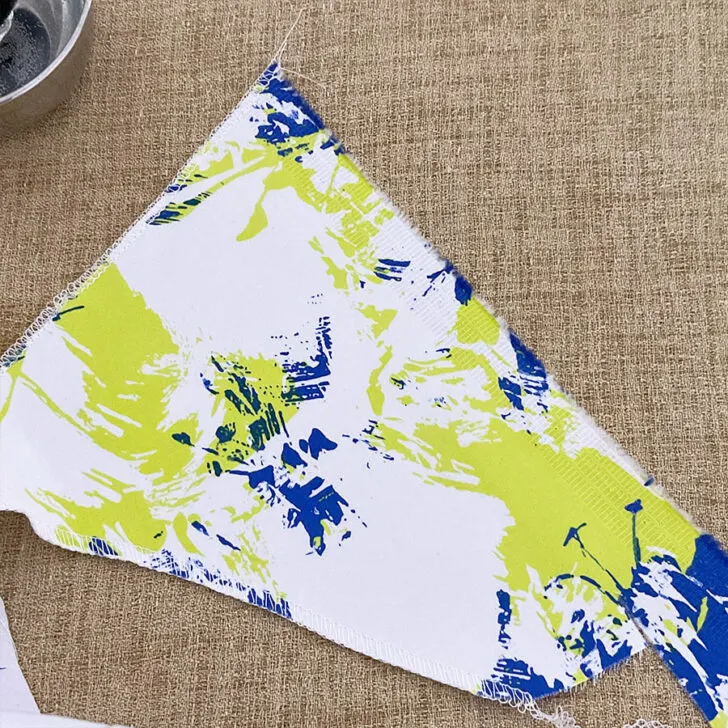
Can You Iron Over Water soluble Thread?
Directly ironing over water soluble thread is not advisable because heat doesn’t dissolve the thread.
Even a hot iron with a high steam doesn’t dissolve the thread.
✅ Related tutorial: Panasonic Cordless Irons: Review and Insights from Daily Use
Can You Take It Out With A Steamer?
No, from my experience, a steamer doesn’t dissolve the thread. You need to put water over the thread for it to disappear.
Does Water Need To Be Warm, Hot, or Cold?
The water temperature for dissolving water soluble thread depends on the brand and type of thread, but lukewarm water is typically effective.
Some threads may need warmer water to dissolve quickly, while others can dissolve in cooler water. Always check the manufacturer’s instructions for optimal results.
Handling and Storage Tips
When using wash-away thread, proper handling and storage are essential to maintain its quality and usability.
Always store the thread in a dry place. Moisture can cause it to dissolve. Avoid places with high humidity levels, which may break the thread before use.
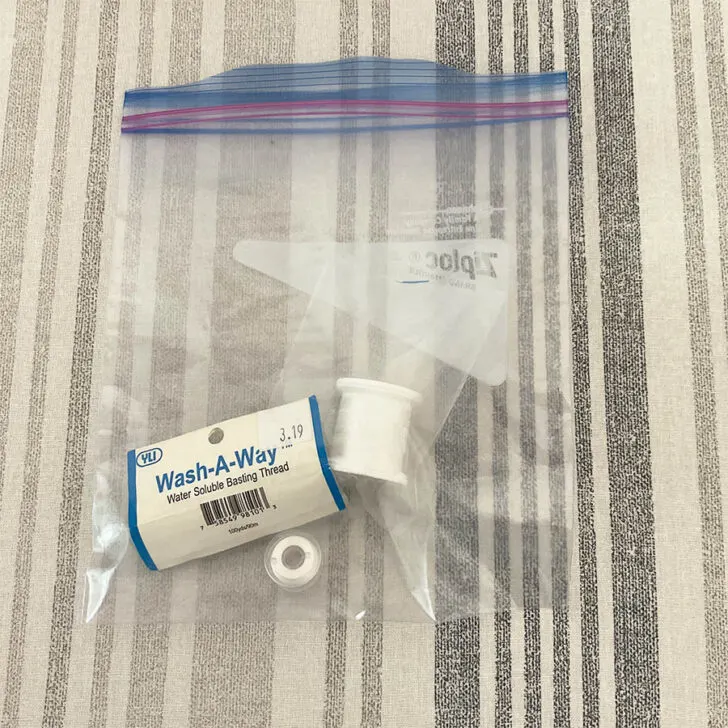
Thoroughly dry your hands before handling the thread to prevent dissolution.
Load the thread into your machine swiftly to minimize exposure to moisture present in the room.
Environmental Impact and Sustainability
When you choose wash-away thread, you’re using a material that dissolves in water. This characteristic is both beneficial and potentially concerning from an environmental standpoint.
Wash-away threads are a zero-waste alternative to regular thread which is good. But these threads are not made of natural materials, so their breakdown products may still contribute to environmental pollution.
Materials such as PVA (polyvinyl alcohol), commonly used in these threads, are generally considered non-toxic. However, there is no clear information about the implications of byproducts and residuals from dissolving this material in large quantities.
Choosing the Right Water Soluble Thread
Several brands produce water soluble thread, and here are some of the well-known ones.
Superior Threads
They offer 2 products called Vanish-Lite and Vanish-Extra, which are both water soluble threads suitable for various sewing and quilting needs.
Note: Some of the links on this page are affiliate links. This means I will receive a commission if you order a product through one of my links. I only recommend products I believe in and use myself.
YLI Corporation
YLI offers a water soluble basting thread. That’s what I use – I buy it in a Canadian Fabricland store.
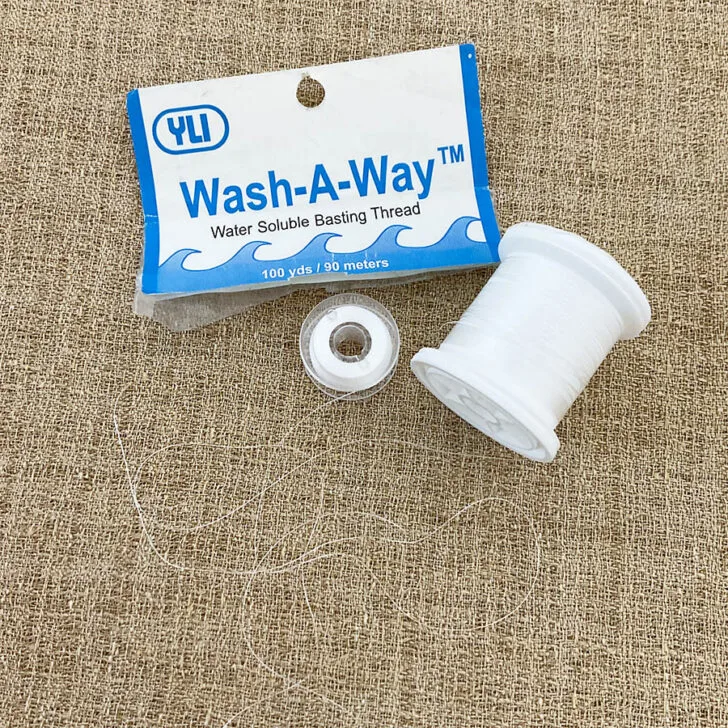
Smartsolve Water Soluble Thread

SmartSolve Water-Soluble Thread
Bohin Water Soluble Thread
Madeira
Wonderfill Rinse ‘n Gone Water Soluble Thread
Loved this guide and want to keep it for later? Simply pin the image below to your sewing Pinterest board, and you can easily come back to this article whenever you need a refresher on water soluble thread. Don’t forget to follow me on Pinterest follow me on Pinterest too for step-by-step tutorials, tips, and the creative inspiration.

latest posts
- Knot a Problem: Easy Ways to Secure Short Thread Ends
- Ever Tried This on Your Serger? This Differential Feed Feature Will Amaze You
- Ditch My Sewing Machine? Not in This Lifetime!
- Adorable DIY Needle Book | Easy Tutorial for Beginners
- Master the Seam Ripper: Your Ultimate Guide to Precision Stitch Removal
- Think You Know Zippers? This Installation Guide Might Surprise You
- Why Does Your Seam Ripper Have a Red Ball? Discover Its Purpose!
- Topstitching Troubles? This Simple Trick Will Turn It Around Instantly!
- How to Sew Shirring: A Step-by-Step Guide to Elastic Thread Gathering




